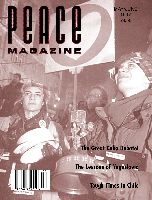
Peace Magazine May-June 1997, page 30. Some rights reserved.
Search for other articles by R.M. Baxter here
FabiÁN Escalante. Translated Maxine Shaw. Melbourne: Ocean Press,1995, 199 Pages.
General Fabián Escalante joined the Cuban State Security Department (G-2) shortly after Fidel Castro gained power, and rose to be chief of the organization. This book is based on information from the files of G-2 as well as published Cuban and American material. It tells a complex and confusing story involving an unsavoury gang of mercenaries, gangsters and other ruffians. These include veterans of the overthrow of the Arbenz government in Guatemala, future Watergate plumbers, and individuals who kept changing sides. It is well written, but lacks a map of Cuba.
"Covert action is activity which is meant to further the sponsoring nation's foreign policy objectives, and to be concealed in order to permit that nation to plausibly deny responsibility." This definition, quoted by the author from a 1975 U.S. Senate report on alleged assassination plots against foreign leaders, does not reveal the nastiness and meanness of such action. Arson in department stores and the assassination of literacy teachers are not things that any country can take pride in sponsoring. Even nonviolent activities can be distasteful; in 1961 a rumor was circulated that the government would take control of children away from their parents, leading frightened parents to send thousands of children to the U.S.
The CIA took an interest in Fidel Castro even before the overthrow of Batista; they did not want a leftist government to come into power in Cuba as had happened in Guatemala a few years earlier. However, they also had doubts about Batista, and rather than support him they chose to sponsor more conservative revolutionary groups. When Castro succeeded they supported attempts to overthrow him that began almost immediately. Rafael Trujillo, the dictator of the Dominican Republic, tried to organize an invasion but failed, probably because the conspiracy was penetrated by G-2 agents. At about that time some of Castro's former associates tried to seize control. Quick government action defeated this too.
The CIA then decided to mount their own operation. The aim was not so much to overthrow Castro from within as to disrupt civil society to provide justification for an American invasion to restore order. In the mistaken belief that counter-revolutionary guerrilla groups could duplicate Castro's success, they infiltrated such groups into Cuba. These were quickly destroyed, largely by people's militias. At the same time they contrived various schemes against Castro personally, to kill him by shooting, poison, or an exploding cigar, or to discredit him by administering hallucinogens developed in the CIA laboratories or by causing his beard to fall out by administering thallium salts.
Larger infiltrations were carried out to provide internal support for the Bay of Pigs invasion, but these groups too were destroyed or captured and were of little or no help to the invaders. After the defeat of the invasion, counter-revolutionary activity in Cuba continued on a larger scale than ever, always with the CIA's support under the code name of Operation Mongoose. One goal was to attack the American base at Guantánamo and blame it on Castro, giving the United States an excuse to invade. At the same time a campaign of psychological warfare was undertaken to weaken public confidence in the government. Plans to assassinate Castro continued. One failed only because a capsule of poison broke before it could be put in a milkshake that he had ordered. Tons of weapons and communications equipment were sent into the country, and schools for terrorists were established. Operation Mongoose failed largely because G-2 penetrated it. Much of the author's account of this is based on statements by captured agents.
The Operation officially ended early in 1963. Since the U.S. had pledged not to invade Cuba in return for the withdrawal of Soviet missiles, the counter-revolutionary forces in the country could no longer hope for a U.S. invasion to support them. No doubt, however, covert action in Cuba continues, and this helps to explain, though it cannot justify, repressive aspects of the Cuban government which distress many who otherwise view it with sympathy.
In a curious reference, it is claimed that in 1962 a U.S. military intelligence agent paid a Canadian to introduce into Cuba a disease to infect turtles. It would be interesting to know who this venal Canadian was, and how U.S. military intelligence thought making turtles sick would advance their cause.
Reviewed by R. M. Baxter, a retired research scientist living in Hamilton, ON.

Peace Magazine May-June 1997, page 30. Some rights reserved.
Search for other articles by R.M. Baxter here